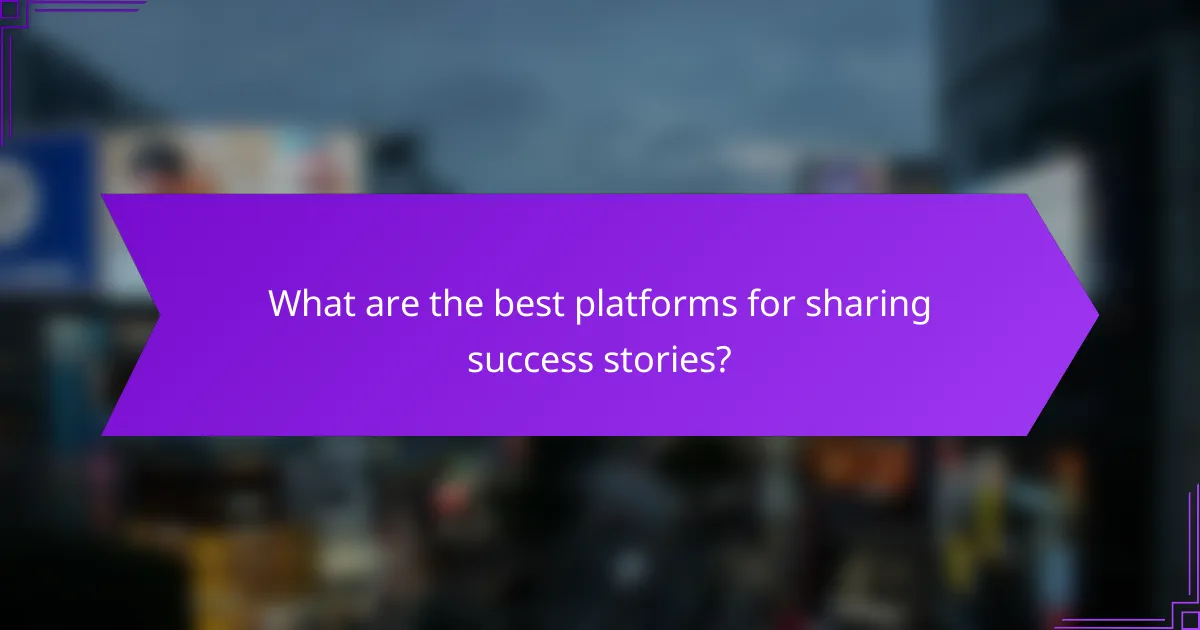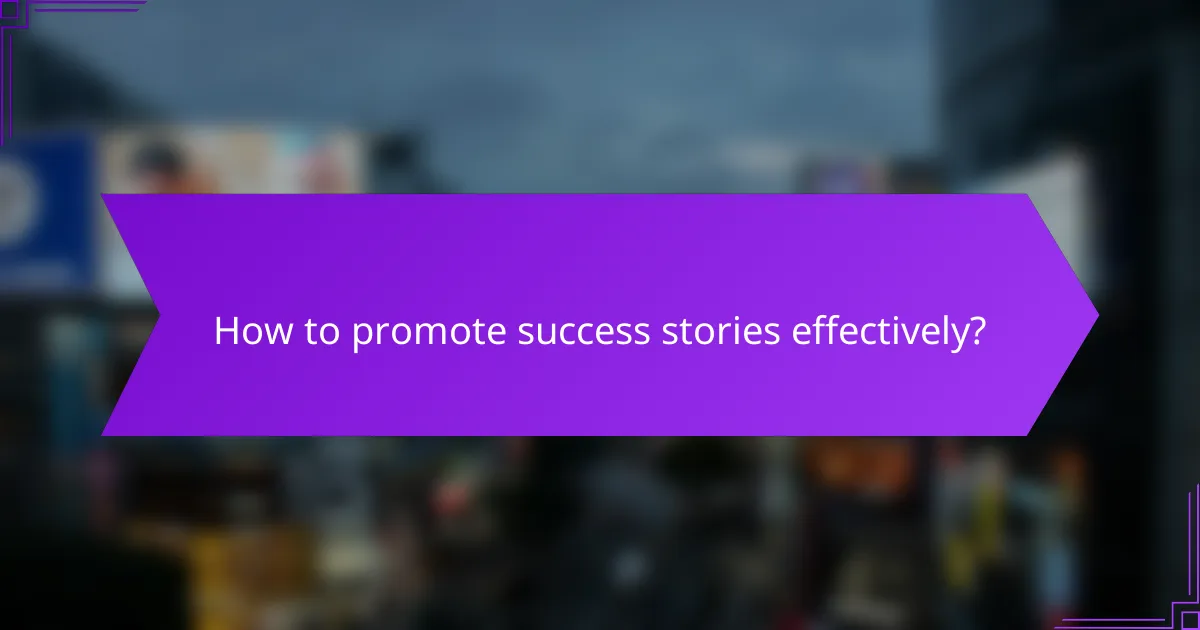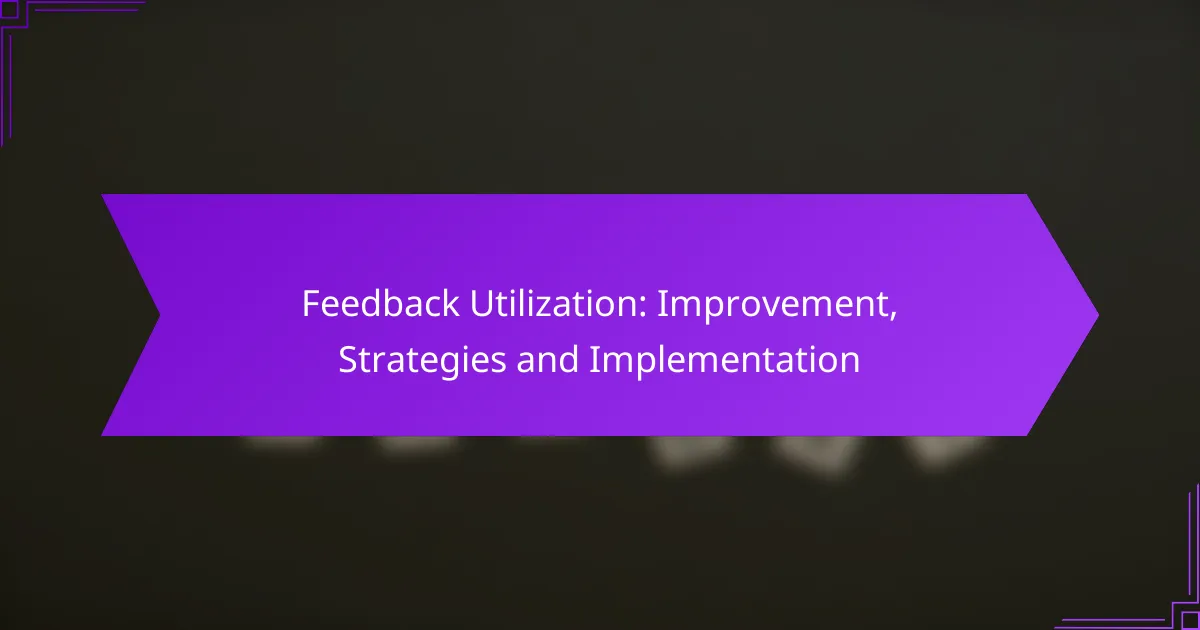Sharing success stories is a powerful way to connect with audiences and inspire others. Utilizing platforms such as Medium, LinkedIn, and social media can enhance visibility and engagement, allowing narratives to reach a broader audience. A well-crafted success story combines a clear problem, effective solutions, and measurable results, making it both compelling and relatable.

What are the best platforms for sharing success stories?
The best platforms for sharing success stories include Medium, LinkedIn, Facebook, Instagram, and Twitter. Each platform offers unique features that cater to different audiences and storytelling styles, allowing individuals and organizations to effectively promote their narratives.
Medium for storytelling
Medium is a popular platform for long-form storytelling, allowing users to publish articles that can reach a wide audience. The clean interface and reader-friendly design make it easy to share detailed success stories, insights, and personal experiences.
When using Medium, focus on crafting compelling narratives that engage readers. Utilize images and formatting options to enhance your story’s appeal. Consider joining relevant publications on Medium to increase visibility and reach a targeted audience.
LinkedIn for professional networking
LinkedIn is ideal for sharing success stories within a professional context. It allows users to connect with industry peers and showcase achievements, making it a powerful tool for personal branding and networking.
To effectively share success stories on LinkedIn, tailor your content to highlight professional milestones and skills. Use engaging headlines and include relevant hashtags to improve discoverability. Engaging with comments and sharing posts can further enhance your visibility.
Facebook for community engagement
Facebook is a versatile platform that fosters community engagement and interaction. Sharing success stories on Facebook can help build connections with friends, family, and followers, creating a supportive environment for feedback and encouragement.
Utilize Facebook groups to share your stories with like-minded individuals. Incorporate multimedia elements like videos and images to make your posts more engaging. Regularly interact with your audience to create a sense of community around your success narratives.
Instagram for visual storytelling
Instagram excels in visual storytelling, making it perfect for sharing success stories through images and short videos. The platform’s focus on aesthetics allows users to create visually appealing content that captures attention quickly.
When sharing on Instagram, use high-quality visuals and concise captions to convey your message. Leverage Instagram Stories and Reels for more dynamic storytelling. Engaging with followers through comments and direct messages can foster a deeper connection.
Twitter for real-time updates
Twitter is a fast-paced platform suited for sharing quick updates and highlights of success stories. Its character limit encourages concise messaging, making it ideal for sharing impactful quotes or key achievements.
To maximize your reach on Twitter, use relevant hashtags and engage with trending topics. Consider creating a thread to elaborate on your success story, allowing for a more detailed narrative while still keeping it brief. Regularly interact with your audience to build a following and encourage sharing.

How to promote success stories effectively?
Promoting success stories effectively involves using various digital marketing strategies to reach a wider audience and engage them meaningfully. By leveraging platforms like social media, email, and SEO, you can enhance visibility and drive interest in your narratives.
Utilize social media advertising
Social media advertising is a powerful tool for promoting success stories due to its extensive reach and targeting capabilities. Platforms like Facebook, Instagram, and LinkedIn allow you to create tailored ads that can engage specific demographics based on interests, location, and behavior.
Consider using eye-catching visuals and compelling headlines to grab attention. A/B testing different ad formats can help identify what resonates best with your audience, ensuring higher engagement rates.
Leverage email marketing campaigns
Email marketing campaigns can effectively share success stories with your existing audience. By crafting personalized emails that highlight key achievements, you can foster a deeper connection with your subscribers.
Segment your email list to tailor messages for different groups, increasing relevance. Use engaging subject lines and include clear calls to action, encouraging recipients to read more or share the stories with their networks.
Engage with influencers
Collaborating with influencers can amplify the reach of your success stories. Influencers often have established trust with their followers, making their endorsement valuable for promoting your narratives.
Identify influencers whose values align with your brand and propose partnerships that allow them to share your stories authentically. This approach can introduce your content to new audiences and enhance credibility.
Optimize for SEO
Search engine optimization (SEO) is crucial for ensuring your success stories are discoverable online. By using relevant keywords, optimizing meta descriptions, and creating high-quality content, you can improve your search rankings.
Focus on long-tail keywords that potential readers might use to find similar stories. Regularly updating your content and ensuring mobile-friendliness can also enhance your visibility in search results.
Host webinars or live events
Hosting webinars or live events can provide an interactive platform to share success stories. These formats allow for real-time engagement, enabling you to connect with your audience and answer their questions directly.
Promote your events through social media and email campaigns to maximize attendance. Consider recording the sessions and sharing them later to extend the reach of your success stories beyond the live audience.

What are the key elements of a compelling success story?
A compelling success story includes a clear problem statement, a detailed solution description, measurable results, an engaging narrative style, and visual elements or testimonials. These components work together to create a persuasive narrative that resonates with the audience and showcases the impact of the solution.
Clear problem statement
A clear problem statement outlines the specific challenge faced by the individual or organization. It should be concise and relatable, allowing the audience to understand the context and significance of the issue. For example, a company might struggle with declining sales due to increased competition.
Identifying the problem accurately sets the stage for the solution, making it essential to articulate the pain points effectively. Use straightforward language to ensure clarity and engagement.
Detailed solution description
The solution description should provide a comprehensive overview of the approach taken to address the problem. This includes the strategies, tools, or methodologies implemented to achieve the desired outcome. For instance, a business might adopt a new marketing strategy or invest in technology to enhance operations.
Detailing the solution helps the audience understand the thought process behind the actions taken and demonstrates the feasibility of the approach. Be specific about the steps involved and any challenges encountered during implementation.
Measurable results
Measurable results are crucial for validating the effectiveness of the solution. This section should highlight specific outcomes, such as percentage increases in sales, customer satisfaction scores, or cost reductions. For example, a company could report a 30% increase in sales within six months of implementing the new strategy.
Using quantifiable data provides credibility to the success story and allows the audience to gauge the impact of the solution. Whenever possible, include before-and-after comparisons to illustrate the transformation clearly.
Engaging narrative style
An engaging narrative style captures the audience’s attention and keeps them invested in the story. Use a conversational tone and incorporate storytelling techniques, such as anecdotes or relatable scenarios, to make the content more appealing. For example, sharing a personal experience related to the problem can create a connection with readers.
Consider the pacing and flow of the narrative to maintain interest. A well-structured story with a clear beginning, middle, and end will resonate more effectively with the audience.
Visual elements and testimonials
Incorporating visual elements, such as images, infographics, or videos, enhances the storytelling experience and makes complex information more digestible. Visuals can illustrate key points or showcase results, making the success story more impactful.
Testimonials from clients or stakeholders add authenticity and credibility to the narrative. Including quotes or case studies can strengthen the message and provide social proof of the solution’s effectiveness. Aim for a mix of visuals and testimonials to create a well-rounded presentation.

What criteria should be used to select success stories for promotion?
To effectively select success stories for promotion, focus on criteria such as relevance to the target audience, measurable impact, and diversity of experiences. These factors ensure that the stories resonate with viewers and demonstrate tangible benefits.
Relevance to target audience
Success stories should directly address the interests and needs of the target audience. Consider the demographics, preferences, and pain points of the audience to ensure the stories are relatable and engaging.
For example, if promoting a product aimed at small business owners, select stories that showcase how the product solved specific challenges faced by similar businesses. This targeted approach enhances connection and trust.
Impact and measurable outcomes
Highlighting the impact and measurable outcomes of the success stories is crucial for credibility. Use quantifiable results, such as percentage increases in sales or reductions in costs, to illustrate the effectiveness of the solution.
For instance, a story might detail how a marketing campaign led to a 30% increase in customer engagement over six months. Such metrics provide tangible proof of success and can motivate potential customers to take action.
Diversity of experiences
Incorporating a variety of experiences in success stories broadens appeal and demonstrates that solutions can work across different contexts. This diversity can include various industries, company sizes, and geographical locations.
For example, showcasing success stories from both a tech startup and a traditional retail business can illustrate the versatility of a product or service. This approach helps potential customers see themselves in the stories being told.



